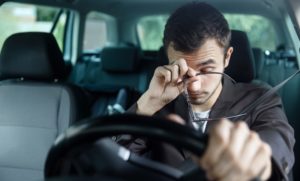Drowsy Driving Meeting Kit

Drowsy Driving Safety Talk
There are many hazards we face today anytime we operate a motor vehicle. Weather, poor road conditions, and wildlife are some common hazards on the road today. One very deadly activity that is taking place far too often is drowsy driving.
Tackling these issues can be difficult when our values frequently do not align with avoiding drowsy driving. In a 24/7 society, with an emphasis on work, longer commutes, and exponential advancement of technology, many people do not get the sleep they need.
What Employees Need to Know About the Danger of Drowsy Driving
Lack of sleep may cause a condition known as micro sleep—a brief moment of sleep that can last for up to 30 seconds. When driving at 65 miles an hour, a driver that nods off for three seconds will travel approximately 95 yards (nearly the length of a football field). In those few seconds, the driver could run into the car in front of them, they could swerve and hit a wall or drive into a ditch.
Symptoms a drowsy driver may experience:
- Frequent blinking, heavy eyelids, rubbing eyes
- Drifting from lane to lane, tailgating, or grazing the shoulder of the road or rumble strip
- Missing exits and street signs (a major telltale sign of fatigue and drowsiness)
- Yawning, can’t keep head up
- No memory of the last few miles
- Difficulty focusing on the road
IMPACT OF DROWSY DRIVING
NHTSA’s census of fatal crashes and estimate of traffic-related crashes and injuries rely on police and hospital reports to determine the incidence of drowsy-driving crashes. NHTSA estimates that in 2017, 91,000 police-reported crashes involved drowsy drivers. These crashes led to an estimated 50,000 people injured and nearly 800 deaths. But there is broad agreement across the traffic safety, sleep science, and public health communities that this is an underestimate of the impact of drowsy driving.
Causes of Drowsy Driving
- Lack of sleep- The amount of things we have going on in our lives can make it hard to get plenty of sleep.
- Medical issues- Certain medical issues or health conditions can bring the onset of drowsiness even if a person has had plenty of sleep. One common example is thyroid issues.
- Drugs/ alcohol- Drugs and alcohol on their own can cause an obvious hazard while driving. When they are paired with a lack of sleep or medical issues, it can be an extremely dangerous situation.
Avoid Drowsy Driving
- Get plenty of sleep. Most experts recommend at least 7 hours of sleep.
- Eat a good diet and drink plenty of water. Taking care of your body is important to be able to function at optimal levels.
- Consult your doctor for an unusual or excessive fatigue. It could be a symptom of an underlying health issue.
- Never drink and drive. Use caution even when only using prescribed medication. Many medications cause drowsiness.
- Pull over when drowsiness is setting in. A ten minute nap can make the difference in whether or not you make it to your destination.
- Develop a schedule for long road trips and plan stops along the route.
- Take the Federal Motor Carrier Safety Foundation (FMSCA)’s “Drowsy Driving Quiz” with your employees. This quiz will test your knowledge about drowsy driving and make everyone more aware of the facts surrounding drowsy driving.
- Discuss with them the importance of driving defensively and avoiding distractions.
IMPORTANCE OF DROWSY DRIVING PREVENTION PROGRAM
Any business that has employees operating motor vehicles on the company’s behalf, or has employees at high risk for driving while fatigued (e.g., shift workers, young people, business travelers), should have Explicit Policies and Educational Programs with respect to drowsy driving.
Put Drowsy Driving Policies in Writing. Your company may already have a written driving policy, but does it include a section explaining your policies with regard to drowsy driving? Any written driving policy should clearly indicate how much sleep an employee must have before getting behind the wheel of a vehicle and should describe how the company expects employees to handle drowsy driving situations.
A Strong Drowsy Driving Education Program Should Contain At Least Three Core Elements, Including:
- A discussion about the facts, myths, signs and risk factors for drowsy driving.
- A presentation on good sleep habits and their importance.
- An exploration of strategies for avoiding drowsy driving situations.
FINAL WORD
Do not be a drowsy driver. Take the necessary precautions to avoid putting yourself in a dangerous situation. Pay attention to the drivers around you and practice defensive driving techniques to protect yourself from other drivers who may be driving drowsy.